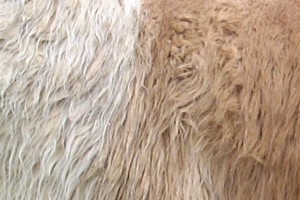About Llamas: Llama Fibre
One of the finest natural fibres in the world

Llama/alpaca fibre is one of the finest natural fibres in the world. In South America, whether it comes from a llama or alpaca it is considered the same product with the two identifiers merely acting to denote grade. All fine fibre is referred to as alpaca and any coarser fibre is referred to as llama. Not very fair to the llama's reputation as a fibre producing animal but the truth none-the-less. Llama fibre is almost completely lanolin free and is actually a hollow hair as compared to "wool". It is lightweight and very strong with amazing thermal properties.
One of the best qualities (aside from it's fineness) of this fibre is the fact that it is hypo-allergenic making it easy to wear for just about everyone. It is lovely when blended with sheep's wool, cashmere or silk.
Llama fleece type can vary from animal to animal but falls into 4 main categories. One is the double-coated llama where there is a distinct outer coat of coarser guard hair and then a much finer undercoat. The second is the silky type. Silky fibre is slippery to the touch and can have a great deal of lustre. Suri, the third type is similar to silky in that it can be slippery to the touch and have lots of lustre but with the addition of twisting or "locking" into distinct strands and being quite heavy or drapey when knitted or woven. The fourth type is huacaya which is a single coat of fine dense fibre that has lots of loft or crimp. Some guard hair can be found in any of the latter three types but breeding programs over the years have animals with guard hairs so fine that they are nearly indiscernible from the main fleece.
The goal of many llama breeders who are focussed on fibre is to build a North American natural fibre industry that can supply fibre artists such as weavers, spinners and knitters and eventually move to large scale supply to shops and fibre co-operatives. It is an exciting proposition to be involved in the grass roots start up of an industry that could prove to be very viable in both Canada and the U.S.
